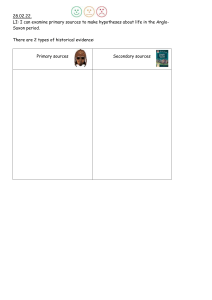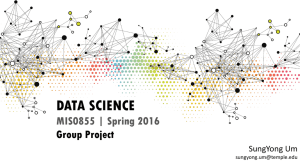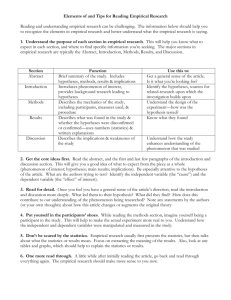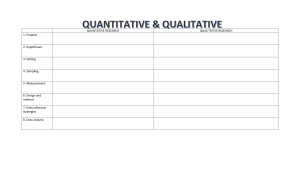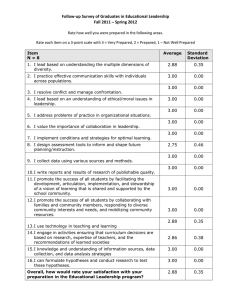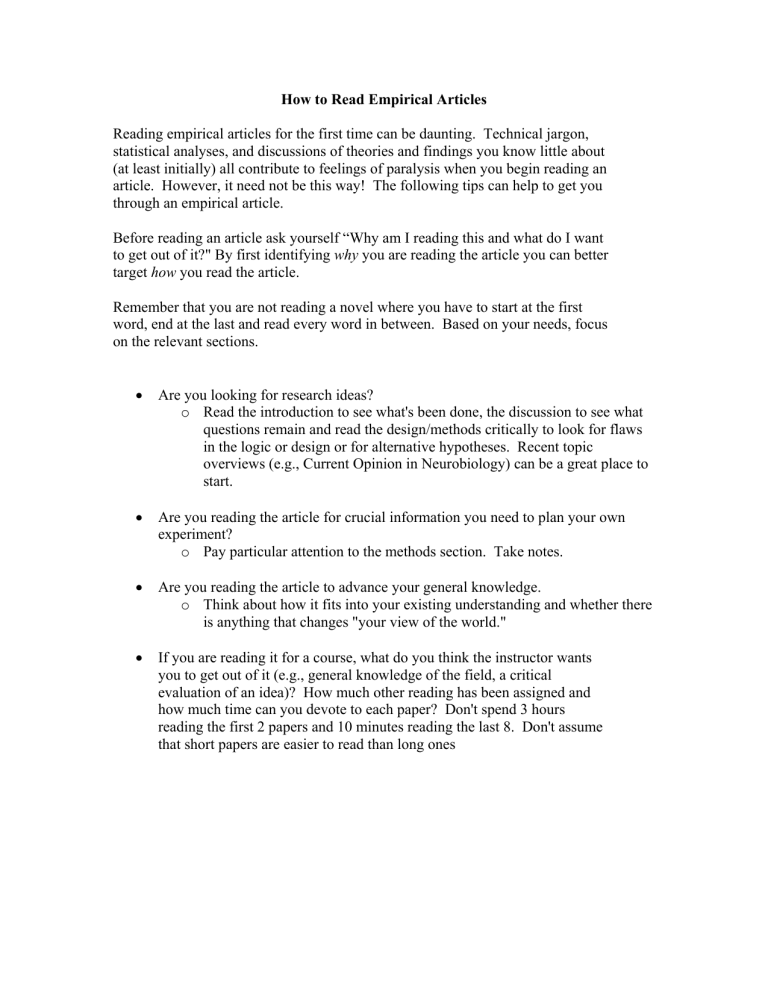
How to Read Empirical Articles Reading empirical articles for the first time can be daunting. Technical jargon, statistical analyses, and discussions of theories and findings you know little about (at least initially) all contribute to feelings of paralysis when you begin reading an article. However, it need not be this way! The following tips can help to get you through an empirical article. Before reading an article ask yourself “Why am I reading this and what do I want to get out of it?" By first identifying why you are reading the article you can better target how you read the article. Remember that you are not reading a novel where you have to start at the first word, end at the last and read every word in between. Based on your needs, focus on the relevant sections. • Are you looking for research ideas? o Read the introduction to see what's been done, the discussion to see what questions remain and read the design/methods critically to look for flaws in the logic or design or for alternative hypotheses. Recent topic overviews (e.g., Current Opinion in Neurobiology) can be a great place to start. • Are you reading the article for crucial information you need to plan your own experiment? o Pay particular attention to the methods section. Take notes. • Are you reading the article to advance your general knowledge. o Think about how it fits into your existing understanding and whether there is anything that changes "your view of the world." • If you are reading it for a course, what do you think the instructor wants you to get out of it (e.g., general knowledge of the field, a critical evaluation of an idea)? How much other reading has been assigned and how much time can you devote to each paper? Don't spend 3 hours reading the first 2 papers and 10 minutes reading the last 8. Don't assume that short papers are easier to read than long ones 1. Understand the purpose of each section in an empirical article. This will help you know what to expect in each section, and where to find specific information you’re seeking. The major sections are as follows: abstract, introduction, methods, results, and discussion. The APA manual describes theses sections (pp. 10 – 29). Here are the basics: Section Abstract Introduction Methods Results Discussion Function Brief summary of study. Includes hypotheses, methods, results & implications Introduces phenomenon of interest, provides background research leading to hypotheses Describes the mechanics of the study, including participants, measures used, and procedure Describes what was found in the study and whether the hypotheses were disconfirmed or confirmed. Uses both numbers (statistics) and should include explanations in prose. Describes the implications and weaknesses of the study. Use this to: Get a general sense of the article. Is it what you’re looking for? Identify the hypotheses, source for related-research upon which the investigation builds upon Understand the design of the experiment – how was the hypothesis tested? Know what they found. Understand how the study extends/changes our understanding of phenomenon X 2. Get the core ideas first. Read the abstract, and the first and last few paragraphs of the introduction and discussion section. This will give you a good idea of what to expect from the piece as a whole (phenomenon of interest; hypotheses; main results; implications). Be especially attentive to the hypotheses of the article. What are the authors trying to test? Identify the independent variable (the “cause”) and the dependent variable (the “effect” of interest). 3. Read for detail. Once you feel you have a general sense of the article’s direction, read the introduction and discussion more deeply. What led them to their hypothesis? What did they find? How does this contribute to our understanding of phenomenon X? Note any statements by the authors (or your own thoughts) about how this article changes or augments the original theory. 3. Put yourself in the participants’ shoes. While reading the methods section, try to imagine, as vividly as possible, being a participant in the experiment. This will help to make more concrete the actual experiment. Understand how the conceptual independent and dependent variables were actually manipulated and measured in the study (i.e., operationalized). 4. Don’t get bogged down in the statistics, but do understand what was found. If you feel comfortable with statistics, by all means puzzle through all the analyses in the results section. For the less experienced/confident, know that most good articles will 1) first present the numbers, then 2) talk about what the results mean in regular prose. Focus on extracting the meaning of the results. Also, look at any tables and graphs, and how they are described in the text. 5. At least one more read through. A little while after initially reading the article, go back and skim through everything again. See if it all “fits together” now that you’ve had time to reflect on the piece. Note anything new you noticed or realized about the article. Adapted from: Culham, J. (2006). How to Read a Journal Article. Retrieved November 28, 2006 from http://defiant.ssc.uwo.ca/Jody_web/Culham_Lab_Docs/Advice/how_to_read_a_jou rnal_article.htm. Jordan, C. H. & Zanna, M. P. (1999). How to read a journal article in social psychology. In R. F. Baumeister (Ed.), The self in social psychology (pp. 461-469). Philadelphia, PA: Psychology Press. Oyamot, C. Reading Empirical Articles: Some Tips. Retrieved November 28, 2006 from http://www.psych.sjsu.edu/~neldred/Dr.%20Oyamot's%20How%20To%2 0Rea %20An%20Empirical%20Article.htm.
